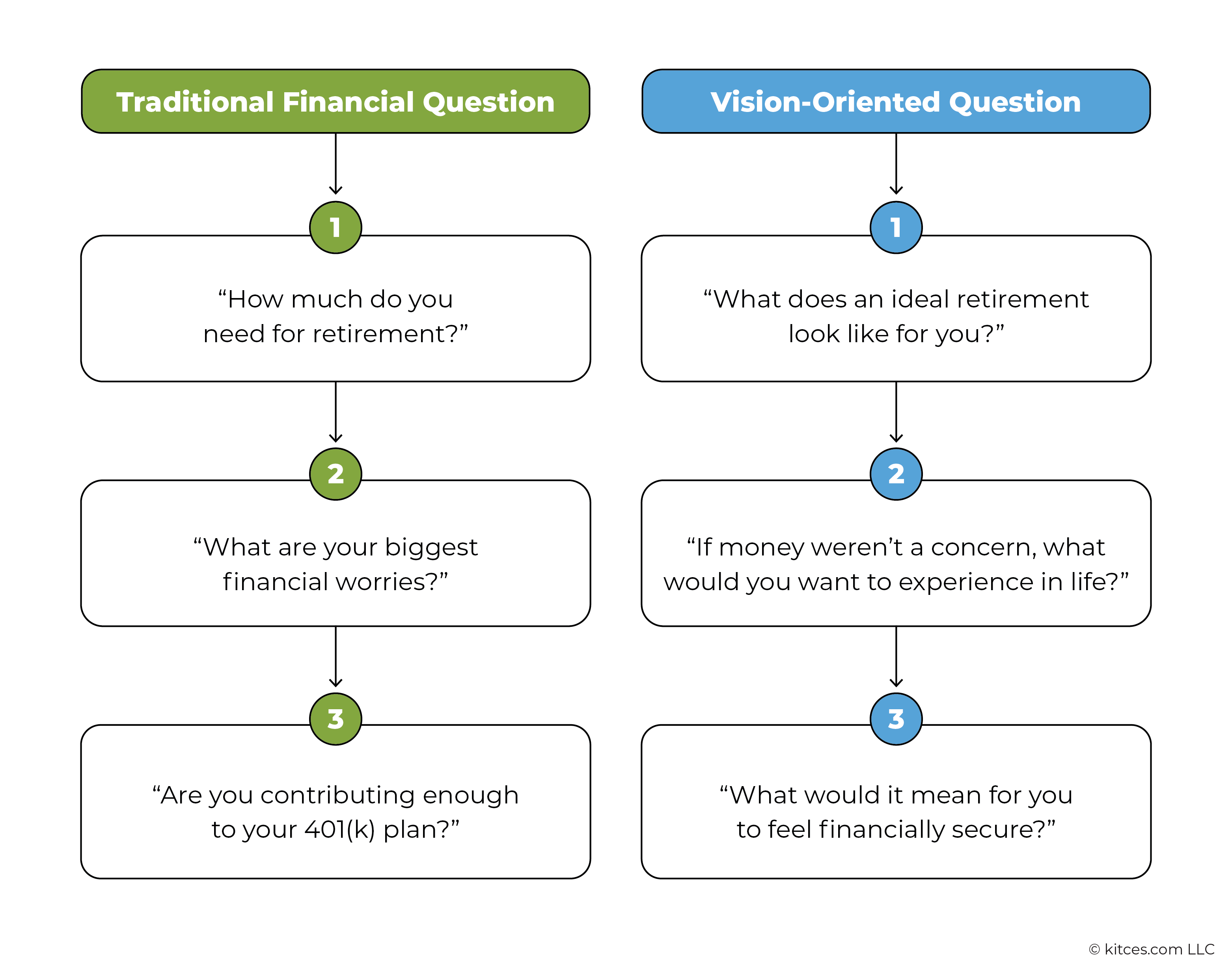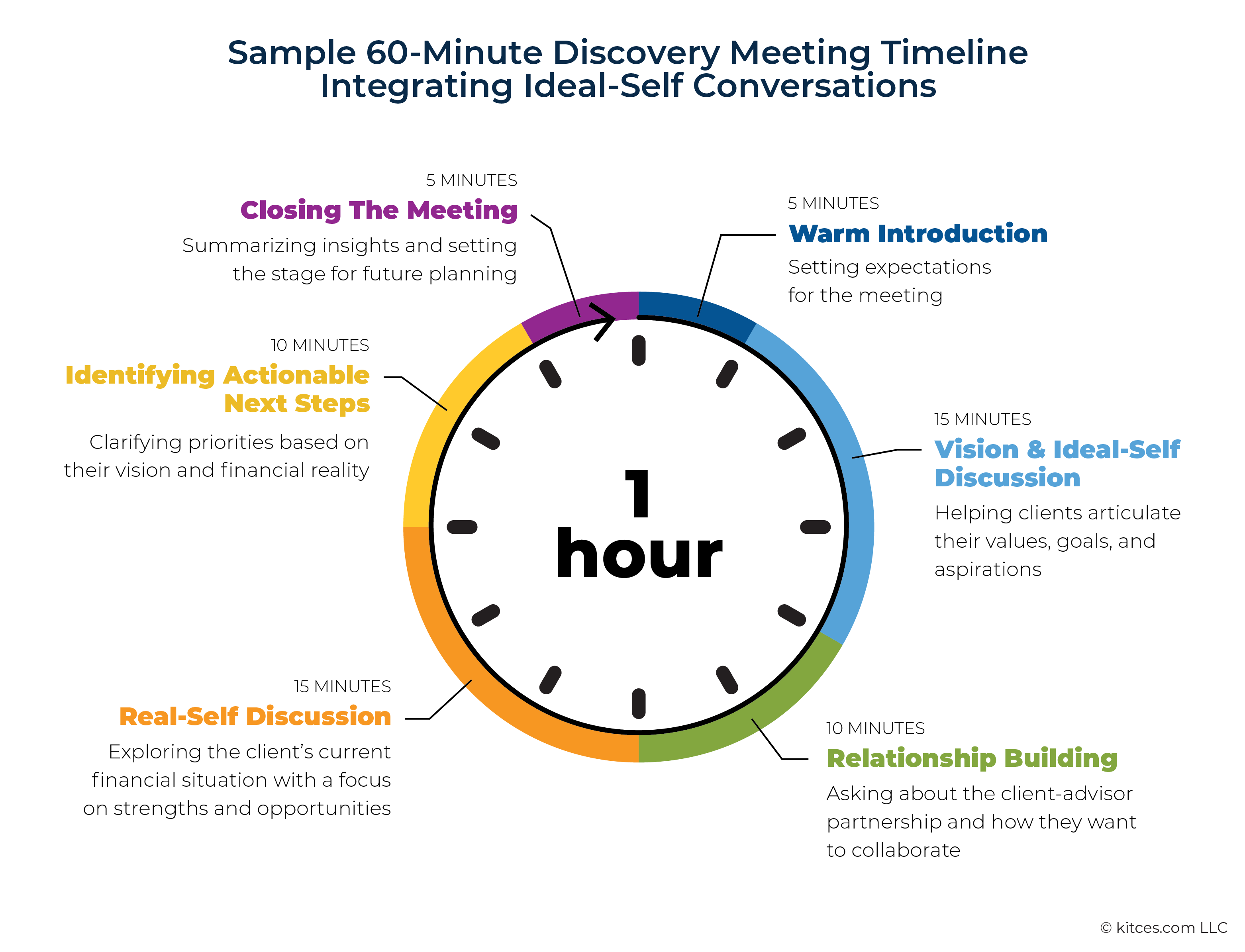Executive Summary
It's natural for advisors to begin discovery meetings by asking questions about a client's current financial situation – understanding cash flow, debt, investments, risk tolerance, or even the burning tax concern that brought them to the advisor's door in the first place is crucial for financial planning. However, starting with these questions can have unintended consequences. Psychologically, when people assess their current reality, they tend to see what's missing – focusing on limitations and risks rather than what's possible.
Beginning discovery meetings by discussing financial concerns can trigger what psychologists call the Negative Emotional Attractor (NEA) – a psychological and physiological state linked to stress, problem-solving, and risk aversion. Which can narrow the client's cognitive focus, making them more likely to fixate on short-term issues rather than long-term growth, feel defensive, resist new ideas that challenge their current financial habits, and ultimately heighten their anxiety rather than inspire action.
By contrast, when advisors activate the Positive Emotional Attractor (PEA) – a state triggered by conversations about a person's ideal self, hopes, and possibilities – clients respond in a far more productive way. They become more open to new ideas, engaging more deeply in the financial planning process and feeling more motivated to take action.
With this in mind, opening meetings with "vision" questions that activate the PEA state – rather than "numbers-based" questions that encourage clients to focus on their current situation – can help clients create an emotional bridge between financial goals and personal fulfillment. For instance, rather than starting a conversation by asking, "How much do you need for retirement?" (which focuses a client on numbers and the possibility that they might not have saved enough), an advisor might instead ask, "What does an ideal retirement look like for you?" (which allows the client to first articulate their positive vision for retirement). Vision-oriented questions can also help clients clarify what they want from an advisor (e.g., "What qualities or values would you like to see in our partnership?") and view financial planning as a way to support the life they envision – helping them align their resources with what matters most (e.g., "How would having a clear financial plan help you become the person you aspire to be?").
After focusing on a client's "ideal self" through vision questions at the beginning of a discovery meeting, the next step is to guide the client gently toward their current financial reality. During this "real self" portion of the conversation, advisors can use reflective, nonjudgmental questions to explore the client's real self (e.g., "What financial decisions have helped you move toward this vision?"). Finally, closing the discovery meeting by summarizing key takeaways, identifying one or two meaningful next steps, and reinforcing financial planning as an ongoing process that supports their long-term goals can leave clients feeling clear, motivated, and excited about the financial planning process.
Ultimately, the key point is that financial planning is about more than numbers – it's about helping clients create a life that aligns with their values, aspirations, and long-term goals. By restructuring discovery meetings to start with vision-oriented questions that encourage ideal-self conversations, advisors can transform the planning process from a technical discussion into an inspiring and deeply meaningful personal journey. Framing the conversation this way doesn't ignore financial realities – it ensures that financial decisions are grounded in purpose, increasing engagement and long-term commitment to financial planning!
Discovery meetings are a foundational step in building a successful financial planning relationship. They set the tone, establish trust, and provide advisors with the insights needed to create a plan tailored to a client's needs. Yet, insights from the science of change suggest that many discovery meetings inadvertently limit client growth – often by focusing first on a client's current financial situation, or what coaching psychology refers to as their "real self".
When clients enter a financial planning meeting, they often bring concerns: Am I saving enough for retirement? Will I be okay if the market drops? Can I afford to retire early? While these are important questions, diving straight into balance sheets and problem-solving may not be the best way to inspire meaningful financial change.
Recent research in Intentional Change Theory (ICT) suggests that conversations centered on the "real self" – encompassing financial gaps, concerns, and obstacles – can activate the Negative Emotional Attractor (NEA), a psychological state linked to stress, defensiveness, and resistance to new ideas. While discussing financial realities is a necessity, starting the conversation by addressing these challenges can cause clients to focus on limitations rather than possibilities. They may feel stressed or ashamed, or even perceive their advisor as someone who is there only to 'fix' their problems.
An alternative approach, rooted in ICT, begins with vision-oriented questions that explore the client's "ideal self". This strategy taps into the Positive Emotional Attractor (PEA), a psychological state opposite of the NEA that fosters hope, creativity, and openness to change. By helping clients imagine what's possible before assessing their current reality, advisors can create a more engaging and motivating discovery process.
Understanding the psychological impact of these two approaches can help advisors structure discovery meetings that encourage client growth – starting with possibility before addressing challenges. By framing conversations and questions around the ideal self, advisors can activate a more productive mindset, making clients more receptive to meaningful financial change.
Why Focusing On The Present "Real Self" Can Limit Client Growth
It's natural for advisors to begin discovery meetings by asking questions about a client's current financial situation. Many require 'the numbers' before even meeting with a potential client. And certainly, understanding cash flow, debt, investments, risk tolerance, or even the burning tax concern that brought them to the advisor's door in the first place is crucial for financial planning. However, starting with these questions can have unintended consequences.
From a psychological perspective, when people are asked to assess their current reality, they tend to focus on limitations, risks, and what's missing – rather than on what's possible. Research in coaching psychology has suggested that when conversations begin by reflecting on problems, people often feel constrained and less open to change.
For example, imagine a client who walks into a discovery meeting worried about their retirement savings. They know they've done okay and believe meeting with a planner is important, but they're unsure if it's the right next step. If the conversation starts with questions about their 401(k) plan balance, expenses, and projections, they may begin to feel anxious about whether they're 'on track'. This anxiety can make it harder for them to engage in big-picture thinking about the kind of life they truly want to build in retirement. This is one reason why talking with prospective clients who feel financially fine – but uncertain – can be challenging. Leading with concerns rather than opportunities can dampen engagement and leave them on the fence.
On the other hand, beginning with vision-oriented questions – such as where they'd like to live in retirement, how they'd spend their time, and what relationships and experiences would matter most – can reframe the financial discussion. Once a client articulates a clear, emotionally compelling vision, they are more motivated to discuss the numbers that will help them get there.
Just as the Transtheoretical Model of Change highlights the importance of readiness in behavior change, financial planning discussions are more effective when clients – both prospective and existing – feel excitement and have positive reasons for making a change before they are ready to dive into the details of planning or taking action. And once clients commit to change, continued support helps them maintain the progress they make and stay engaged in their financial journey!
How Jumping Into Financial Details Too Soon Can Overshadow Vision Creation
Another drawback of leading with real-self questions is that it bypasses the chance to establish an inspiring vision before diving into details. Many clients rarely take the time to envision their ideal financial future. Instead, their concerns are often shaped by immediate challenges – paying off debt, affording a home, and planning for their children's education. While these are all valid priorities, structuring discovery meetings around problem-solving first may prevent clients from exploring what truly excites and motivates them. It can also reinforce the perception that the advisor's role is simply to 'fix' financial issues rather than to help clients build a fulfilling future.
Consider the difference between these two opening questions in a discovery meeting:
Typical Real-Self Question:
"What are your biggest financial concerns right now?"
Ideal-Self Question:
"If you could design your ideal financial future, what would it look like?"
The first question centers on problems, reinforcing a mindset focused on limitations. The second opens the door for possibilities, encouraging clients to think more expansively about what they want rather than what they lack. When clients start by articulating a meaningful vision, they naturally become more engaged and invested in their financial plan.
Real-Self Conversations Can Trigger The Negative Emotional Attractor (NEA)
A final challenge with beginning discovery meetings by discussing financial concerns is that it can trigger what psychologists call the Negative Emotional Attractor (NEA) – a psychological and physiological state linked to stress, problem-solving, and risk aversion. When an individual enters an NEA state, their cognitive focus narrows, making them more likely to:
- Fixate on short-term issues rather than long-term growth;
- Feel defensive or overwhelmed when discussing financial concerns; and
- Resist new ideas that challenge their current financial habits.
While financial advisors are comfortable with problem-solving, clients may not have the same ease when discussing money – especially when the conversation starts with concerns and shortcomings. If a meeting begins by emphasizing financial worries, it can heighten anxiety rather than inspire action.
By contrast, when advisors activate the Positive Emotional Attractor (PEA) state – triggered by conversations about a person's ideal self, hopes, and possibilities – clients respond in a far more productive way. When advisors help clients explore their ideal self, hopes, and possibilities, they:
- Become more open to new ideas;
- Engage more deeply in the financial planning process; and
- Feel more motivated to take action.
For example, if an advisor asks, "What would financial success look like for you beyond just hitting certain numbers?" a client may light up as they describe their vision of financial independence, travel, or giving back to their community. Once this emotional connection is established, they are more willing to engage in the details of how to achieve it.
Introducing The Ideal Self And Vision-Oriented Questions
If beginning with real-self conversations can limit motivation and engagement, then what's the alternative? Intentional Change Theory (ICT) provides a powerful framework for structuring conversations that foster openness, creativity, and long-term commitment to financial planning. Rather than focusing on financial gaps and immediate concerns to start the meeting, ICT suggests that guiding people to first connect with a compelling vision of their ideal self will help them be more likely to embrace change.
By leading discovery meetings with vision-oriented questions, advisors can help clients tap into their intrinsic motivation, making them more receptive to financial strategies that align with their values and aspirations. As Boyatzis, Smith, and Van Oosten (2019) explain in "Helping People Change", sustainable change begins not with fixing problems, but with imagining what's possible. This process activates the Positive Emotional Attractor (PEA) state, increasing openness, curiosity, and motivation.
In financial planning, this means that when advisors start with a client's aspirations, values, and dreams, clients naturally become more engaged in the planning process. Instead of feeling weighed down by their current financial realities, they begin to see the deeper purpose behind their financial decision – transforming planning from a technical exercise into an empowering journey.
This is why vision questions aren't just a 'nice to have' tool in a discovery meeting – they function as a core driver of long-term financial engagement. Many therapists use miracle-style questions; George Kinder's process even begins with the dream-of-freedom question for this exact reason: Vision is powerful.
How Vision Questions Help Clients Move Beyond Numbers
Most financial plans are built around specific numbers – retirement savings, investment performance, cash-flow projections. But numbers alone rarely create a sense of meaningful progress for clients. Vision questions help clients see how financial decisions connect to the life they want to live, creating an emotional bridge between financial goals and personal fulfillment.
Consider the difference between these two approaches:
Traditional Financial Questions
- "How much do you need for retirement?"
- "What are your biggest financial worries?"
- "Are you contributing enough to your 401(k) plan?"
Vision-Oriented Questions
- "What does an ideal retirement look like for you?"
- "If money weren't a concern, what would you want to experience in life?"
- "What would it mean for you to feel financially secure?"
Both sets of questions lead to financial planning discussions, but vision-oriented questions invite clients into a more engaging and aspirational conversation. When clients start by imagining their ideal self, they naturally begin to see how financial planning fits into their bigger picture, making them more willing to engage in the financial details later.
To make this shift actionable, advisors can use the structured vision questions below that help clients articulate their values, aspirations, and expectations for the financial planning relationship.
Strengthening The Advisor-Client Relationship Through Vision Questions
Vision-oriented questions can help clients clarify what they want from an advisor, making it easier to establish trust and long-term engagement.
- "What qualities or values would you like to see in our partnership?"
- "How would you describe an ideal relationship with a financial advisor?"
- "What level of involvement and communication feels right for you in our work together?"
- "How do you envision us collaborating on your financial goals over the years?"
- "Are there specific ways I can help you feel more confident and supported in your financial journey?"
Encouraging Clients To See Money As A Tool For A Meaningful Life
Ideal-self and values-based questions prompt clients to think beyond money as a tool and focus instead on the life they want to build.
- "What are some key values or principles that guide your financial decisions?"
- "How would having a clear financial plan help you become the person you aspire to be?"
- "What does financial success look like to you, beyond numbers and goals?"
- "In what ways do you feel a financial plan could enhance your overall quality of life?"
- "If we looked back in a few years, what impact would you hope this planning process had on your life?"
These ideal-self questions allow clients to emotionally engage with financial planning before discussing specific strategies. Once they have articulated what truly matters, advisors can naturally transition into real-self conversations, showing clients how their financial realities connect with their vision.
Why Vision Comes First In The Discovery Process
Traditional discovery meetings often begin with problem-solving, but behavioral psychology and coaching research suggest that leading with a vision creates stronger client motivation and engagement. By starting with ideal-self questions, advisors can:
- Activate the Positive Emotional Attractor (PEA) state, increasing motivation and openness;
- Make financial planning feel aspirational, not just technical; and
- Strengthen long-term commitment to the planning process.
Leading a discovery meeting with a vision-oriented focus helps clients feel both inspired and prepared for the financial journey ahead. By first exploring aspirations and values, advisors create a foundation of trust and motivation that makes financial discussions more meaningful. And when clients see how financial planning supports their bigger picture, they're more likely to engage deeply in the process with a stronger commitment to their long-term goals.
Structuring A Discovery Meeting To Focus On The Ideal Self
The discovery meeting is one of the most important touchpoints in the advisor-client relationship. It's where clients begin to see the value of financial planning and where advisors lay the groundwork for long-term engagement. By restructuring these meetings to lead with vision-oriented questions, advisors can create a more motivating and meaningful experience for clients.
Rather than immediately diving into balance sheets, cash flow concerns, or financial anxieties, advisors can guide clients through a structured conversation that transitions smoothly from vision to reality. This approach helps clients stay engaged, feel more in control, and view financial planning as a pathway to achieving their ideal selves rather than simply a means of fixing financial problems.
How To Introduce The Vision Conversation
The first few minutes of a discovery meeting set the emotional tone for the entire conversation. Instead of beginning with fact-finding, advisors should use this time to:
- Create a welcoming and relaxed environment;
- Explain how the meeting will unfold and why vision matters in financial planning; and
- Ask ideal-self questions to tap into the client's aspirations and values.
A strong opening frames financial planning as an empowering and personal process, not just a technical service.
Advisors can set up the discussion with a simple framing statement:
Before we get into the details of your finances, I want to start by talking about what really matters to you. A financial plan is only valuable if it helps you live the life you want, so let's explore that first.
Then, they can move into ideal-self questions such as:
- "If we fast forward five or ten years, what would an ideal financial future look like for you?"
- "What would make you feel truly confident and at peace with your finances?"
- "If money weren't a concern, how would you spend your time?"
By starting with big-picture, aspirational questions, clients engage emotionally and intellectually, making them more invested in the planning process.

Nerd Note:
Is "Why now?" still a good opening question? Yes! "Why now?" remains a strong way to initiate a vision-based conversation. While it focuses on the client's current situation, it has a positive, forward-looking spin. Asking a prospective client why now is the right time to start financial planning – rather than six months from now – can help tie the discussion to their future financial vision and what's driving their decisions.
Transitioning From Ideal Self To Real Self: Bridging The Gap Between Vision And Financial Reality
Once clients have had a chance to articulate their vision, the next step is to gently guide them toward their current financial reality – their real selves. At this stage, it's important to avoid an abrupt shift into financial concerns. Instead, framing the transition as a natural next step keeps clients motivated and engaged:
Now that we've talked about what's important to you, let's look at where you are today so we can start making that vision a reality.
This smooth transition prevents the conversation from suddenly feeling like it has shifted into problem-solving mode and keeps the focus on progress rather than obstacles.
Guiding Clients Through The Real-Self Conversation
Advisors can use reflective, nonjudgmental questions to explore the client's real self:
- "What financial habits or decisions have helped you move toward this vision?"
- "What feels like the biggest challenge in aligning your finances with your goals?"
- "Are there any financial concerns that keep you up at night?"
By keeping the real-self discussion grounded in the client's ideal vision, advisors help clients see their current financial situation as part of a journey rather than a judgment.
This transition is crucial because it ensures that discussing financial realities doesn't trigger the Negative Emotional Attractor (NEA) state, which is linked to stress and defensiveness and can lead to clients feeling discouraged. Instead, it allows clients to remain engaged and open to exploring financial strategies that support their long-term aspirations.
Closing The Discovery Meeting With Actionable Next Steps
The final part of the meeting should leave clients feeling clear, motivated, and excited about the financial planning process. To achieve this, advisors can:
- Summarize key takeaways from the conversation, including insights from both the ideal-self and real-self discussions;
- Identify one or two immediate steps that align with the client's vision; and
- Reinforce financial planning as an ongoing process that supports their long-term goals.
Rather than overwhelming clients with a long list of next steps, advisors can prioritize one or two meaningful actions that feel manageable and inspiring, helping clients look forward to the plan presentation meeting that comes next.
Example Closing Structure
- Summarize the Conversation
"Today, we talked about your vision for financial success, including what financial freedom looks like for you. We also explored where you are today and what's working well."
- Highlight the Next Step
"One of the most important things we can do now is focus on [specific action] to move you closer to your vision. Let's start there and build momentum."
- Set the Expectation for Future Conversations
"Financial planning is a journey, and this is just the beginning. Our next meeting will focus on building a personalized plan that aligns with the vision you shared today."
By ending on an optimistic and forward-looking note, advisors reinforce the idea that financial planning isn't just about fixing problems – it's about creating possibilities.
Structuring An Effective 60-Minute Discovery Meeting: Sample Timeline
For advisors who want a structured roadmap, here's a sample 60-minute discovery meeting that integrates ideal-self conversations before diving into financial details.
The graphic below outlines a structured flow for the meeting, ensuring that each phase builds on the last. The first 20 minutes focus on establishing a vision and helping clients articulate their values, goals, and aspirations before financial realities come into play. From there, advisors spend time on relationship building, discussing how the client-advisor partnership can best serve their needs. The real-self discussion follows, exploring financial strengths and opportunities in a way that keeps clients engaged rather than overwhelmed. Finally, the meeting wraps up with actionable next steps and a forward-looking close, reinforcing financial planning as a journey rather than a one-time task.
This structure ensures that vision and values are explored first so that financial discussions feel motivating rather than overwhelming. And don't forget to ask thoughtful follow-up questions to deepen the conversation – helping clients feel heard, supported, and engaged in a positive experience that truly reflects their aspirations.
Financial planning is about more than numbers – it's about helping clients create a life that aligns with their values, aspirations, and long-term goals. By restructuring discovery meetings to start with ideal-self conversations, advisors can transform the planning process from a technical discussion into an inspiring and deeply personal journey.
When clients begin their financial journey with a clear and emotionally compelling vision, they are far more likely to stay engaged, take action, and feel confident in their future. This approach doesn't ignore financial realities – it simply ensures that financial decisions are grounded in purpose rather than driven by fear and uncertainty.
Ultimately, leading with vision builds stronger client relationships, increases motivation, and makes financial planning more meaningful. When advisors help clients see the bigger picture first, they aren't just solving financial problems – they're empowering clients to create the future they truly want!






